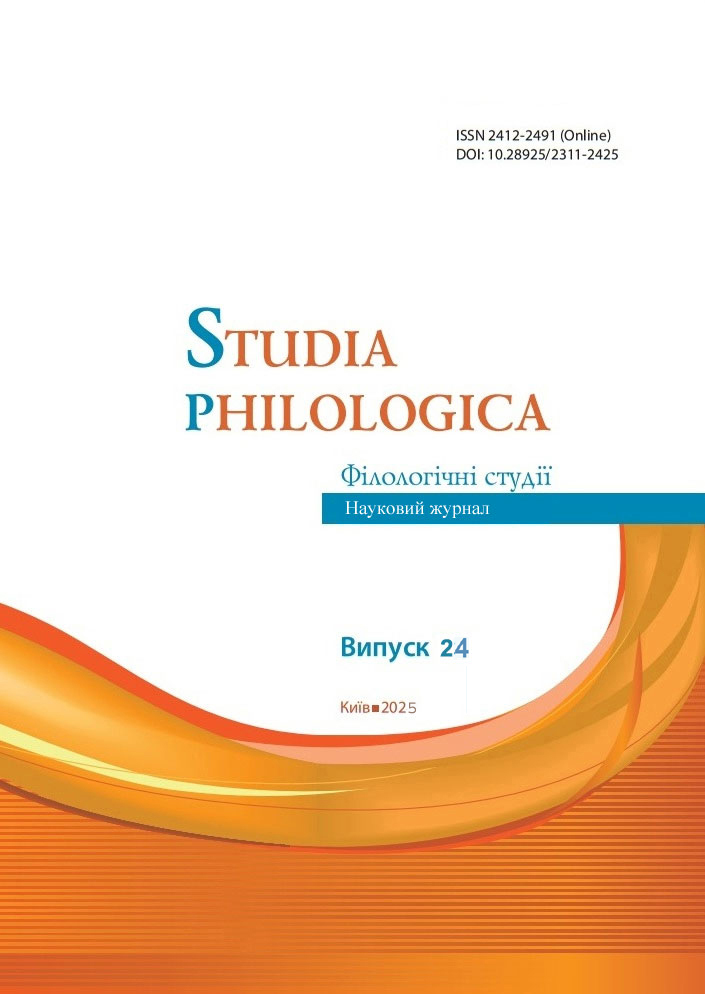Interdiscursivity of the Literary Text: Universal and Idiosyncratic Features
DOI:
https://doi.org/10.28925/2311-2425.2025.249Keywords:
discourse, text, interdiscursivity, prototype, genre, style, communicationAbstract
The article explores universal and idiosyncratic features of interdiscursivity, represented in the selected works of Nobel laureate J. M. Coetzee. Interdiscursivity is defined as a cognitive-communicative strategy for the semantic and structural construction of a literary text, aimed at ensuring the interaction with the reader. It is established that in the examined works, interdiscursivity forms a new model of meaning- and text-creation, characterized by its epistemic properties. These properties are differentiated based on the developed prototype model of discourse, which includes the following features: (1) the type of knowledge underlying the formation of discourse; (2) the pragmatic orientation; (3) the features of linguistic-stylistic, plot-compositional, and narrative organization; (4) the tonal system; (5) the communicative goal. Changes in the epistemic traits of discourse signal a discursive "shift," which is accompanied by the emergence of pragma-stylistic effects such as cognitive-emotional tension, cognitive-emotional dissonance, intensification of reader engagement, semantic gaps/distortion, cognitive overload, etc.
Keywords: discourse, text, interdiscursivity, prototype, genre, style, communication.
Downloads
References
Bhatia, V. K. (2010). Interdiscursivity in professional communication. Discourse & Communication, 21(1), 32–50.
Björk, O., & Iyer, R. (2023). The dialogism of 'telling': Intertextuality and interdiscursivity in early school writing. Linguistics and Education, 74, 1-11.
Fairclough, N. (1992). Discourse and social change. Polity Press.
Fairclough, N. (2003). Analysing discourse: Textual analysis for social research. Routledge.
Foucault, M. (2002). The archaeology of knowledge. Routledge.
Gee, J. P. (2025). An introduction to discourse analysis: Theory and method (5th ed.). Routledge.
Gibbons, A. (2016). Multimodality, Cognitive Poetics, and Genre: Reading Grady Hendrix’s Novel Horrorstör. Multimodal Communication, 5(1), 15-29.
Harris, Z. S. (1952). Discourse Analysis. Language, 28(1), 1-19.
Izotova, N. (2022). The interplay of linguistic means managing the reader's attention: The slow reading method. Language. Culture. Discourse. Kharkiv: РС ТЕСHNOLOGY СЕNTЕR, 33-50. https://doi.org/10.15587/978-617-7319-60-2.3
Jakobson, R. (1960). Linguistics and poetics. In T. A. Sebeok (Ed.), Style in language (pp. 350-377). MIT Press.
Johnstone, B. (2018). Discourse analysis (3rd ed.). Wiley-Blackwell.
Jørgensen, M., & Phillips, L. (2002). Discourse analysis as theory and method. SAGE Publications.
Potapenko, S. I. (2024). Ukrainian President Zelenskyy’s speeches to neighboring states’ parliaments: Media rhetorical perspective. Linguistic Studies, 28, 37-47. DOI: 10.31558/1815-3070.2024.48.3 ISSN: 2308-0019
Roget’s Thesaurus of English Words and Phrases (2005). Longman.
Rosch, E. (1978). Principles of Categorization. In E. Rosch & B. B. Lloyd (Eds.), Cognition and Categorization (pp. 27–48). Lawrence Erlbaum Associates.
Searle, J. R. (1975). The logical status of fictional discourse. New Literary History, 6(2), 319-332.
Talmy, L. (2007). Attention Phenomena. In D. Geeraerts & H. Cuyckens (Eds.), The Oxford Handbook of Cognitive Linguistics (pp. 264–293). Oxford University Press.
Tan, P. K. W. (2023). Literary discourse. In P. K. W. Tan (Ed.), The Routledge Handbook of Discourse Analysis (pp. 278-292). Routledge. DOI: 10.4324/9780367338783-22
Todd, R. W. (2016). Discourse topics. Pragmatics & Beyond New Series.
Van Dijk, T. A. (1982). Episodes as units of discourse analysis. In D. Tannen (Ed.), Analyzing discourse: Text and talk (pp. 177-195). Georgetown University Press.
Van Dijk, T. A. (2008). Discourse and Power. New York: Palgrave Macmillan.
Van Dijk, T. A. (2011). Discourse studies and hermeneutics. Discourse Studies, 13(5), 609-621.
Wu, J. (2011). Understanding interdiscursivity: A pragmatic model. Journal of Cambridge Studies, 6(2-3), 95-115.
Published
How to Cite
Issue
Section
License
Copyright (c) 2025 CC BY 4.0 DEED Attribution 4.0 International

This work is licensed under a Creative Commons Attribution 4.0 International License.


